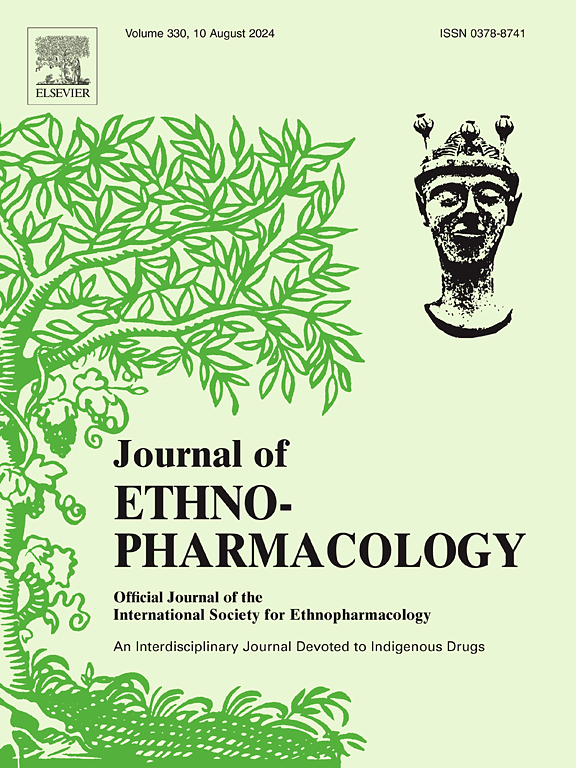亚麻籽总生物碱提取物的体内肠道抗炎、组织病理学和抗氧化调节作用。
IF 4.8
2区 医学
Q1 CHEMISTRY, MEDICINAL
引用次数: 0
摘要
民族药理学相关性:Linum usitatissimum L.,俗称亚麻籽,是线状科的多年生草本植物,传统上用于治疗胃肠道疾病和腹泻。亚麻籽的健康益处和药用价值可归因于一些有益化合物的存在,如ω -3脂肪酸、生育酚、环肽、生物碱、粘液和苯丙素。研究目的:探讨乌利姆种子总生物碱提取物(ALU)对2,4-二硝基苯磺酸(DNBS)诱导的BALB/c小鼠克罗恩病模型的抗炎和抗氧化作用。材料与方法:采用液相色谱-电喷雾质谱联用技术(LC-ESI-MS/MS)对ALU馏分进行化学表征。6组小鼠(n=6)分为健康组、结肠炎对照组、地塞米松治疗组(2.4 mg/kg)和ALU治疗组(50、100、200 mg/kg)。直肠内滴注DNBS (250 mg/kg)诱导结肠炎症,伴有体重减轻、结肠结构改变、炎症细胞浸润和炎症标志物过量产生。组织样本用于评估组织学损伤和最终杯状细胞损失(H & E和PAS染色),并评估炎症和氧化状态(MPO, NO, H2O2, MDA, CAT和GSH)。结果:对LU总生物碱组分进行植物化学分析,发现含有10个化合物。口服ALU(50、100和200 mg/kg)可显著改善小鼠dnbs诱导的结肠炎,且呈剂量依赖性。ALU治疗减轻了体重减轻,降低了体重/长度(W/L)比,并改善了包括腹泻和食物摄入在内的临床结果。组织学分析显示,与地塞米松治疗相比,保留了结肠结构,增强了杯状细胞数量,减少了中性粒细胞浸润,粘膜损伤最小。ALU还促进粘膜愈合和中性粘蛋白保留。此外,ALU通过调节MPO、NO、H2O2、MDA、CAT和GSH等关键标志物发挥了有效的抗炎和抗氧化作用,支持其对结肠炎症的保护作用。结论:本实验结果表明,芡粉生物碱提取物对dnbs诱导的BALB/c小鼠结肠炎模型具有较强的抗炎和抗氧化作用。本文章由计算机程序翻译,如有差异,请以英文原文为准。
Intestinal anti-inflammatory, histopathologic and anti-oxidative regulatory effects of total alkaloids extract from Linum usitatissimum L. (flaxseed) in vivo
Ethnopharmacological relevance
Linum usitatissimum L., commonly known as flaxseed, is a perennial herb in the Lineaceae family that has been traditionally used to manage gastrointestinal disorders and diarrhea. The health benefits and medicinal applications of flaxseed can be attributed to the presence of some beneficial compounds, such as omega-3 fatty acids, tocopherol, cyclic peptides, alkaloids, mucilage, and phenylpropanoids.
Aim of the study
This investigation explored the potential anti-inflammatory and antioxidant properties of the total alkaloid extract of Linum usitatissimum L. seeds (ALU) in a model of Crohn's disease induced by 2,4-dinitrobenzenesulfonic acid (DNBS) in BALB/c mice.
Materials and methods
ALU fraction was chemically characterized by liquid chromatography combined with electrospray ionization mass spectrometry (LC-ESI-MS/MS). Six groups of mice (n = 6) were divided as follow: healthy group, colitic control, Dexamethasone treated-group (2.4 mg/kg) and three group for ALU treatment (50, 100 and 200 mg/kg). Intrarectal instillation of DNBS (250 mg/kg) induced colonic inflammation accompanied by body weight loss, colonic architecture modification, inflammatory cells infiltration and excessive inflammatory markers production. Tissues sample were used to assess the histological damages and eventual goblet cells loss (H & E and PAS staining) and to evaluate inflammatory and oxidative statute (MPO, NO, H2O2, MDA, CAT and GSH).
Results
The phytochemical analysis of total alkaloid fraction of LU revealed the presence of 10 compounds. Oral administration of ALU (50, 100, and 200 mg/kg) significantly ameliorated DNBS-induced colitis in mice in a dose-dependent manner. ALU treatment mitigated body weight loss, reduced the weight/length (W/L) ratio, and improved clinical outcomes, including diarrhea and food intake. Histological analyses revealed that ALU treatment, preserved colonic architecture, enhanced goblet cell numbers, reduced neutrophil infiltration, and minimised mucosal damage, with a comparable effect to dexamethasone treatment. ALU also promoted mucosal healing and neutral mucin retention. Furthermore, ALU exerted potent anti-inflammatory and antioxidant effects by modulating key markers such as MPO, NO, H2O2, MDA, CAT, and GSH, supporting its protective role against colonic inflammation.
Conclusion
These findings indicate that alkaloid fraction extracted from Linum usitatissimum L. have strong anti-inflammatory and antioxidant properties in a DNBS-induced colitis model in BALB/c mice.
求助全文
通过发布文献求助,成功后即可免费获取论文全文。
去求助
来源期刊

Journal of ethnopharmacology
医学-全科医学与补充医学
CiteScore
10.30
自引率
5.60%
发文量
967
审稿时长
77 days
期刊介绍:
The Journal of Ethnopharmacology is dedicated to the exchange of information and understandings about people''s use of plants, fungi, animals, microorganisms and minerals and their biological and pharmacological effects based on the principles established through international conventions. Early people confronted with illness and disease, discovered a wealth of useful therapeutic agents in the plant and animal kingdoms. The empirical knowledge of these medicinal substances and their toxic potential was passed on by oral tradition and sometimes recorded in herbals and other texts on materia medica. Many valuable drugs of today (e.g., atropine, ephedrine, tubocurarine, digoxin, reserpine) came into use through the study of indigenous remedies. Chemists continue to use plant-derived drugs (e.g., morphine, taxol, physostigmine, quinidine, emetine) as prototypes in their attempts to develop more effective and less toxic medicinals.
 求助内容:
求助内容: 应助结果提醒方式:
应助结果提醒方式:


